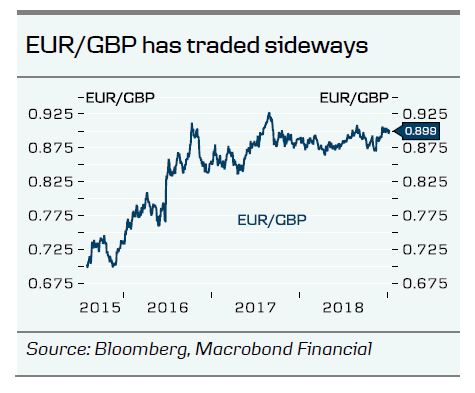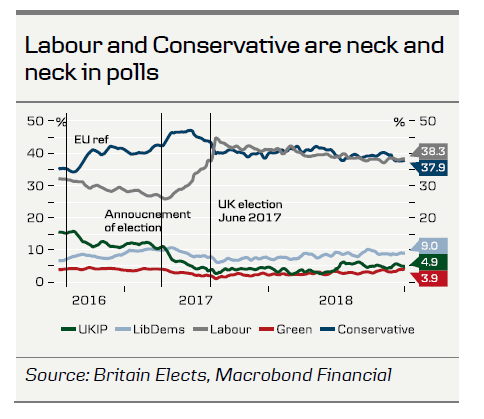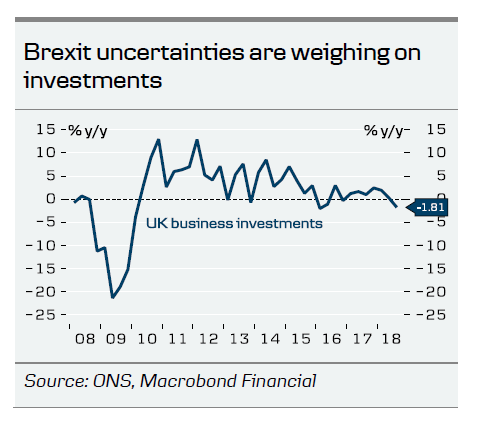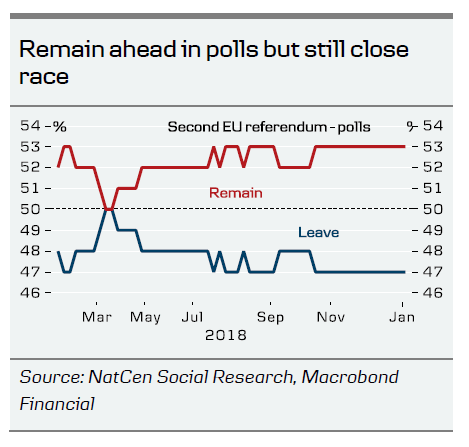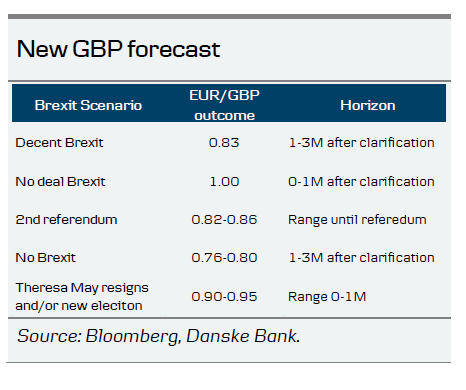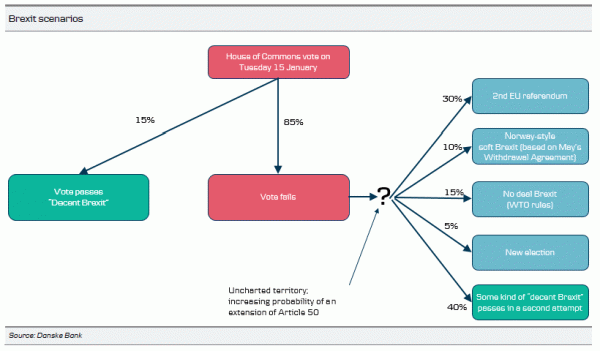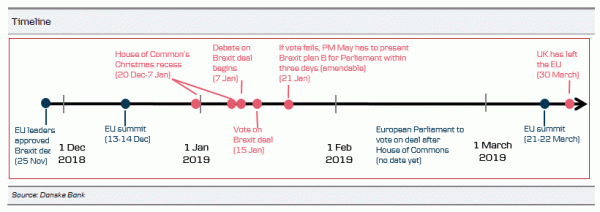The House of Commons went back to business this week and the first thing on the agenda for 2019 was the debate and vote on PM Theresa May’s Brexit deal, which began on Wednesday. The vote is due to take place on Tuesday, 15 January. Nothing seems to have changed since the MPs went on Christmas holiday and the most likely outcome is still that the deal will be voted down next week (we now estimate an 85% probability up from 75% given the development this week, more on that below). PM May’s strategy was to get “further assurances” from the EU, but it has not been sufficient to win MPs over. The EU has very clearly said that it will not renegotiate the withdrawal agreement, but has expressed it is not in the EU’s interest to keep the UK in the backstop indefinitely. The EU would probably like to be more helpful, but has not been able to help May, as she has not told the EU leaders what she needs to get support for her deal.
What happens if the deal is voted down? A defeat seems widely expected, so markets will not react to the defeat itself but to the size of the defeat. A narrow defeat means that she might be able to get it through at a later stage when we are closer to the 29 March deadline, but a big defeat means we are in uncharted territory (and we cannot rule out that Theresa May will resign). Based on her defeat on the so-called “what next” amendment on Wednesday this week, May will be forced to present a Brexit plan B within three days if she loses the vote on Tuesday, which seems very likely. Remember that a previous amendment means that the MPs can debate and amend her plan B. Both mean that the House of Commons has taken more control over the Brexit process, but the problem remains that there is no credible alternative with backing from a majority of the House (also the EU negotiates with government and officials, not parliaments). It also means that PM Theresa May is not able to run down the clock in order to get support for her deal.
We still think some outcomes are more likely than others (see our game tree on page 4). The default option is a no deal Brexit, but it would only happen “by accident”. While some hardcore Brexiteers are advocating a no deal Brexit, there is not a majority for it in parliament and the government’s defeats on several amendments support this view. The problem is that it will happen nonetheless by default unless the centrist MPs from different parties find a common way forward and so far they have failed to do so. We attach a 15% probability of a no deal Brexit (assuming the deal is voted down next week).
We continue to believe the probabilities of a soft Norway-style Brexit and snap election are low (10% and 5%, respectively, assuming the deal is voted down next week). In the soft Norway-style Brexit, there would not be any economic consequences, but the political damage would be significant, as the UK would be subject to all EU laws (including EU contributions and accepting free movement of people) without representation in institutions, agencies, etc. In that case, it would make more sense to just stay in the EU. We think the probability of a snap election is very low. The Prime Minister cannot call for a snap election anymore and this could only occur if (1) the Commons voted for no confidence in the government and no new government was formed within two weeks, or (2) the Commons dissolved itself by a two-thirds majority. It is difficult to see the Conservative MPs having the incentive to support a snap election, as they risk losing their seats (Labour and the Conservatives are neck and neck in the opinion polls).
This leaves us with two possible outcome: either PM Theresa May’s deal (or something very similar) passes the House of Commons at a later stage in a second attempt when we get closer to the deadline, or the politicians agree to call for a second EU referendum. As something needs to settle for the politicians to choose one of the options, we think it is difficult to predict which one is most likely, but at the moment we attach a slightly higher probability of the former than the latter (40% and 30%, respectively, assuming the deal is voted down next week). While it is from an economic perspective positive that PM Theresa May’s deal is probably the hardest realistic version of the Brexit on the table right now, uncertainty is high and the probability is increasing that the UK must ask for an extension of the Article 50 deadline. According to The Telegraph (paywall, 8 January), British officials are “putting out feelers” with the EU for an extension of Article 50. If the Article 50 deadline is extended, the UK may need to hold European Parliament elections, for which there is time enough to call from a legal perspective, but may be very chaotic from a political perspective in the current situation.
What is the argument for the deal passing the House of Commons at a later stage? The main argument is the passing of time. While companies, investors and analysts all seem exhausted from the Brexit uncertainty and think the deadline is very fast approaching, the deadline is still “far away” from a political perspective. As time goes by and 29 March draws closer, the pressure on the politicians increases, which is an argument we have highlighted many times. Soft Brexiteers within the Conservative Party would then be inclined to vote in favour of the deal despite it not delivering the perfect Brexit in their view, as they would fear the alternative would be a majority for a second referendum (something the moderate Conservatives have already threatened). Moderate Labour MPs may support the deal when they find out that a snap election is unlikely. This scenario requires enough politicians willing to compromise eventually.
UK politicians may call for a second EU referendum either if they find out they cannot find a way forward themselves or if moderate MPs start backing staying inside the EU. A second referendum would require an extension of the Article 50 deadline, as it would require at least 4-6 months to organise the referendum. As the UK is on summer holiday in July-August, a second EU referendum would most likely be held in September (perhaps late June at the very earliest but it seems optimistic in our view), meaning that the UK would probably need a nine months extension of Article 50. Staying inside the EU has been made easier as the European Court of Justice has ruled that the UK can unilaterally revoke the Article 50 notification without changes to the existing member terms. Looking at the opinion polls, the share of the voters regretting the Brexit decision is increasing and the remain camp is currently ahead in polls (53% on average versus 47%). Overall, we still see this as very close.
Another way forward could be to ask the EU for a long extension of 9-12 months in order to make time for negotiations on the future relationship. The two main issues for UK politicians have been the Irish backstop and not knowing details of what the future relationship looks like. Looking back at the past two years, the UK and the EU27 were actually supposed to start negotiating the future relationship in 2018 after the first phase of the negotiations was concluded late 2017. Due to internal disputes in the UK, especially over the Irish backstop, this did not happen. By extending the deadline, there will be more time to make the negotiations on the future relationship, without reopening the Withdrawal Agreement, which would probably make it easier for Theresa May to get her deal through parliament. The question is whether the EU would accept such an idea.
FX outlook: key risk to our bullish GBP view is that Brexit clarifications are dragged out
As argued above, it appears likely that PM Theresa May will lose the Brexit vote next week, but markets might react to the size of the defeat. Unless we see a big defeat, we think EUR/GBP is likely to stay boxed in the current 0.88-0.9060 range near term. As the 29 March deadline approaches, upside risks to EUR/GBP may dominate unless we get further clarifications. We thus raise our 1M EUR/GBP forecast from 0.88 to 0.90.
Longer term, our EUR/GBP FX forecast is based on our main scenario that May’s Brexit plan eventually will be approved by parliament. We expect this to pave the way for a significant decline in EUR/GBP. We target 0.84 in 3M, and 0.83 in 6-12M. However, it is a close call and all options are still on the table, meaning the post Brexit outcome space for EUR/GBP remains extremely wide, which will keep volatility high.
That said, we still attribute the highest probabilities to either a decent Brexit (Theresa May’s Brexit plan in some form) or a new referendum and both are positive for GBP in our view. Especially, if a second referendum is called, we expect GBP to appreciate as the probability distribution is likely to shift substantially in favour of ‘NO Brexit’ and ‘Decent Brexit’. We expect EUR/GBP to settle in the 0.82-0.86 range until the referendum (most likely in September) in this scenario.
Hence, a key risk to our bullish GBP view is that Brexit clarifications are dragged out – even beyond 30 March if Article 50 is extended, and the GBP appreciation consequently will be much more moderate and materialise later than our forecast (main scenario) implies. In a scenario where the EU and UK agree to extend Article 50 in order to further negotiations about the future relationship, this would be moderately positive for GBP as it increases the probability that the UK parliament eventually will support the deal.
FX strategy: Short EUR/GBP via options
Timing a possible break lower in EUR/GBP is very difficult and given the high degree of uncertainty related to Brexit, we prefer to position for GBP appreciation via FX options. We are short EUR/GBP via 1M-4M put calendar spread as one of our FX Top Trades for 2019 (the sold 1M put has expired in our FX Top Trades). Risk premiums (EUR/GBP volatility) is much lower compared to the peak in December, and we still like to position for a lower EUR/GBP by selling 1M puts and buying 3-6M puts.
Hedging GBP income/asset
We generally recommend hedging GBP income/assets by buying EUR/GBP call options. In our view, volatility (option price) is fair given the risk of a bounce in EUR/GBP and not least given the downside potential in our main scenario and other GBP positive scenarios such as a new referendum or ‘no Brexit’.
Corporate clients should consider to hedge the entire 2019 flow via 4-6M call options. Hedges can then subsequently be swapped out to the actual pay dates when Brexit is clarified. The risk to this strategy is that Brexit remains unresolved when the bought options expire, which then would require one to buy another period of protection. Hedging GBP expenses
We are approaching the end of the Brexit path, and we recommend clients hedging GBP payables to use bounces in the spot to increase hedge ratios and hedge horizons via FX forwards. Given the risk of a prolonged period of uncertainty clients could consider hedging via risk reversals (1-3M).




